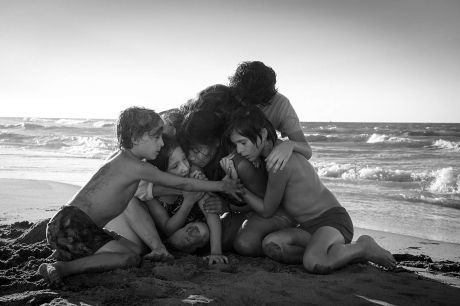Arts
You are here
Roma speaks to today

January 21, 2019
The opening shots alone make it worth seeing Roma. In just a few minutes, this extraordinary film manages to pack in a universe of place and time. And it just gets better from there.
Roma is a largely autobiographical film by writer/director and cinematographer Alfonso Cuarón (Gravity, Y tu mamá también). Set in 1970 in Mexico City’s Colonia Roma, a well-off neighbourhood, it is the story of a middle-class family told mainly through the eyes of Cleo (Yalitza Aparicio). A domestic worker from Oaxaca, she performs all the drudgery work of the household – but she also tucks her employer’s kids in at night, and gently wakes them up in the morning. She is ‘part of the family’ – except that she is not.
In subtle and brutal ways, we are reminded throughout that although she tends to every need of the family, the family does not tend to her every need. As she and her fellow domestic worker Adela quietly talk, switching from Spanish to their native Mixtec, she learns that her mother will lose her home to landlords stealing the land. She lives this torture in isolation, unbeknown to her employer’s family. This private drama is situated in a broader context of the battle between Mexico’s impoverished Indigenous and Mestizo population and the very rich, who are primarily of European ancestry.
Some of the scenes are surreal, tragic and comic at the same time: at Christmas, a wealthy family and its entourage tromp uselessly about, trying to put out a fire that has been mysteriously set on their estate. Allusions to peasant resistance to land encroachment hang in the air.
Cuarón’s film is dedicated to Liboria Rodriguez, the Indigenous woman who raised and cared for him in a dysfunctional family. It also weaves throughout a subtle homage to other childhood influences, with nods to the fascination with the “space age” that captured the imaginations of children – rich and poor – in that era.
Gender, race and class
At first, Roma’s slow pace is almost unnerving, as sounds (in Dolby Atmos) literally surround you. Filmed in black and white in 65 mm, with sparse dialogue, it is a visual and audible immersion.
What is successively revealed, from the first shots of a paving tile washed in soapy water, to the household, to the cityscape and beyond, is a society with its colonial past and tension-filled and violent present. In the process, a multilayered picture emerges of the intricate interconnections of gender, race and class.
One of the most exciting aspects of the film is the performance by Yalitza Aparicio, a pre-school teacher from Tlaxiaco, in Oaxaca state. This was her first time acting, and she drew on her own experience and roots to play this role. Aparicio’s mother is a nanny, and Aparicio herself has experience as a domestic worker.
Reflecting on the film’s portrayal of the Corpus Christi massacre of 120 students in 1971, Aparicio explained in a recent interview how her own experience as a student-teacher in Oaxaca connected with these events: “I was able to relate to the time happening in the film because unfortunately there are lots of things happening that are very similar, even today. There was recently the case of the teachers, from the Ayotzinapa Rural Teachers College. They [43 student teachers] disappeared, which is so horrible and terrifying. I was able to witness many of these tragedies as a student. I was there.”
Roma is steeped in the political turmoil of the era and society it portrays. But it speaks to so many of the issues we confront today, from the treatment of domestic workers, to the impunity of governments, to the suppression of Indigenous language and rights. If you can, do yourself a favour and see it on the big screen, to truly experience the foregrounding of the domestic worker who is too often – almost always – unseen and unheard.
Section:










